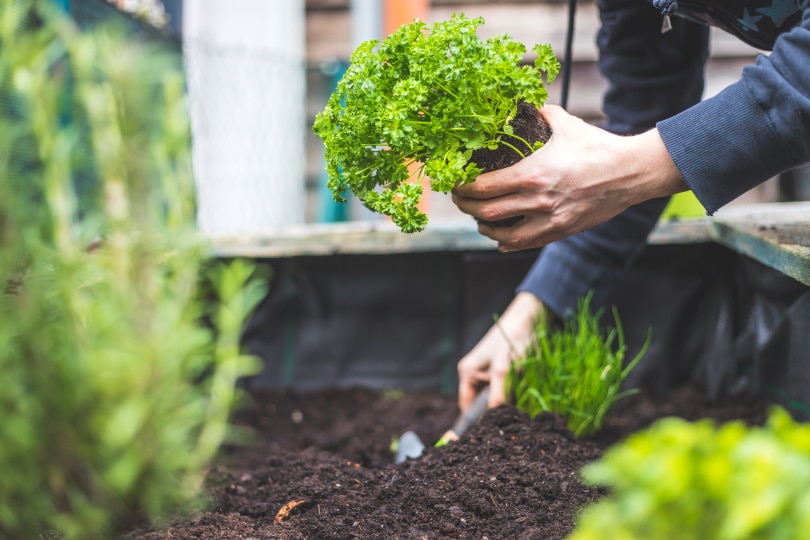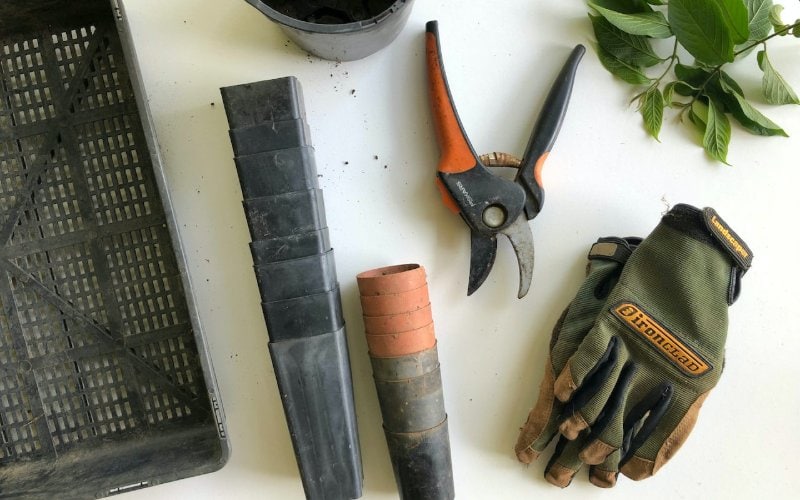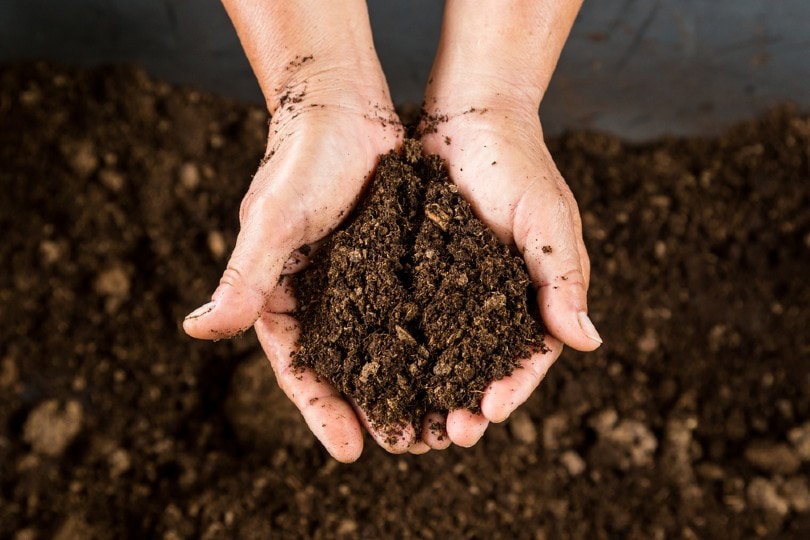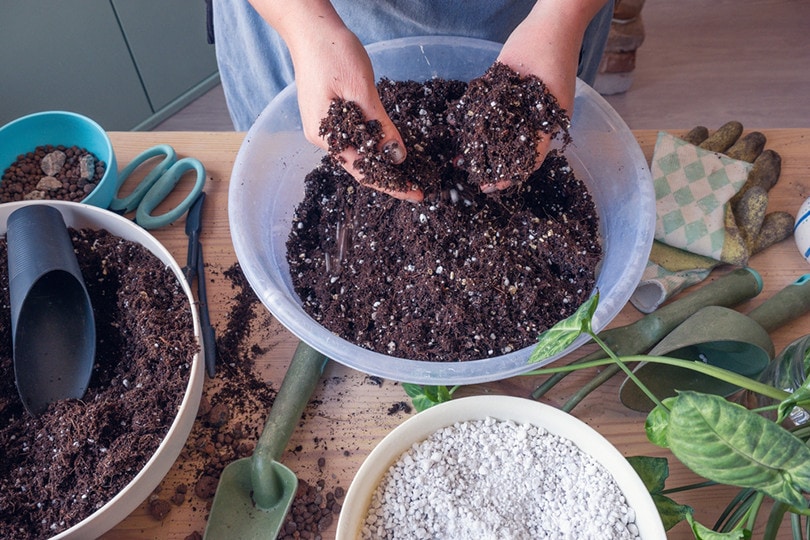How To Make Potting Soil for Vegetables (Step-by-Step Guide)
-
Ed Malaker
- Last updated:

Potting soil is an extremely important tool for any gardener. However, commercial brands can get expensive, especially if you need a lot, and not all of us live next door to a home improvement store. Luckily, potting soil isn’t that hard to make at home, and any supplies you need to buy will go a long way.
Keep reading while we provide a step-by-step guide to making potting soil that works perfectly for growing vegetables and flowers to help you obtain a better harvest.
Before You Begin
Before you start making your potting soil, we recommend you get several ingredients together to have everything you need in one place. You will need a large bucket, pail, or trashcan to hold the soil that you are making. It will also help you store it if you make too much. You will need a shovel, gardening gloves to protect your skin, and a few ingredients, like peat moss, coconut coir, limestone, vermiculite, perlite, and fertilizer.

Tools & Materials
- Gardening gloves
- Trowel or shovel
- Large container
- Peat moss
- Compost
- Vermiculite
- Perlite
- Fertilizer
Consider Your Plants
Another thing you will need to do before you get started is to consider what plants you will grow. Peat moss is a great base for many potting soils, but it tends to be more acidic than its main alternative, coconut coir. Therefore, you want to use peat moss for plants that enjoy a more acidic environment, like tomatoes, corn, cucumbers, broccoli, squash, and onions, but switch to coconut coir for peas, spinach, cabbage, and garlic.
A little research into any vegetable will tell you what kind of soil it needs. That said, you can raise the pH of peat moss, making it less acidic by adding limestone.

Use Peat Moss
- Broccoli
- Corn
- Cucumbers
- Onions
- Squash
Use Coconut Coir
- Cabbage
- Garlic
- Peas
- Radish
- Spinach
Vegetable Potting Soil Recipe
- 6 gallons of sphagnum peat moss or coir fiber
- 6 gallons compost
- 4.5 gallons perlite
- ¼ cup lime
- 1.5 cups fertilizer
1. Mix Peat Moss & Compost
Mix the peat moss or coconut coir in your large container with the compost. The mix should be even and consistent, with no large patches of either material. We found it easiest to mix smaller amounts of the ingredients before adding them to the larger tub. Mixing with your hands also produces better results, but wear gardening gloves, especially when working with peat moss, as it can irritate the skin.

2. Add in the Lime & Fertilizer
If you are using peat moss instead of coconut coir, we recommend mixing in ¼ cup of limestone to help raise the pH so it will be more suitable for your garden vegetables. Like in the last step, we want the mix to be even and consistent throughout the soil. You will also add your fertilizer in this step, even if you use the coconut coir. Adding these two ingredients in this step will help ensure you get a good, even blend.
3. Mix in the Perlite
The final step is mixing in our perlite. It’s much easier to get a consistent mix with this item because it’s easy to see the small white balls, and once you get a good mix, the other ingredients probably have a nice blend as well, so your soil is ready to use.

FAQ
How Do I Use My Potting Soil?
Use your DIY vegetable potting soil to fill your indoor and outdoor pots to get them ready to grow tomatoes, cucumbers, peppers, and many other vegetables. You can also use your potting soil to help improve the soil in your garden.
What Should My Potting Soil Look Like?
Your potting soil should be light and fluffy, with plenty of tiny air pockets that allow water to drain and roots to grow. The roots also require air to extract nutrients. The denser and more compact the soil, the more it will retain water, which can lead to root rot and other problems affecting your harvest.
How Often Should I Fertilize?
The best way to ensure your vegetables are getting the nutrients they need is to use a commercial vegetable fertilizer suitable for the plants you are growing and follow the instructions carefully. All fertilizers will need you to reapply them at specific intervals, and you might also choose to use one fertilizer while the plants are growing and another while they are producing vegetables.

Should I Add Garden Soil to My Potting Soil?
No. You can add potting soil to garden soil to help make it better draining, but you shouldn’t add garden soil to the potting soil. Garden soil tends to be clumpy, retaining too much moisture and making it harder for the roots to grow. Clumpy soil is also hard to work with and may not contain the nutrients your plants need.
Does Potting Soil Go Bad?
Unfortunately, your potting soil will go bad if you store it too long. The compost, peat moss, and coconut coir can start to break down, robbing the soil of its nutrition and ability to drain quickly. Commercial potting soils can contain even more ingredients that can’t withstand a length of storage. If you did accidentally make too much, storing it in an airtight container out of direct sunlight can help it last longer.
Conclusion
Potting soil is very easy to make at home and will work as well as any commercial brand. Combine compost, peat moss, perlite, and fertilizer to create a soil that drains well yet provides your plants with the nutrition they need to grow healthy and strong so you can receive a large harvest.
If you are growing a vegetable like garlic that doesn’t like the acidic environment peat moss creates, use coconut coir instead, and use a fertilizer formulated for the kind of vegetables you are growing and reapply it as directed for a better gardening experience.
Featured Image Credit: Patrick Daxenbichler, Shutterstock
Contents
